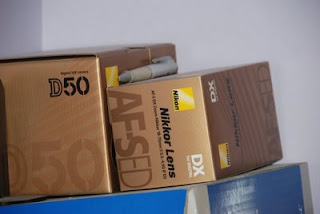Today, I got curious about flash and the manual lenses. I wondered how I could use flash with a manual focus lens. Whenever I trie
 d an MF lens, the flash icon on my LCD would blink, telling me it cannot activate the built-in flash. Well, today, I decided to shoe in my SB-800 speedlight, as I know it can be operated in manual mode. In manual mode, you set the output strength and the flash fires when the shutter opens. Simple operation. I then got curious. Can my D80 set the built-in flash to manual mode as well? I kicked myself in the butt after looking up the menu. Truth be told, my memory is getting rusty because I have looked at this menu before. The option to turn on manual mode is there, I just forgot about it. So now I could simply use the built-in flash in many situations with MF lenses. I am getting off tangent ...
d an MF lens, the flash icon on my LCD would blink, telling me it cannot activate the built-in flash. Well, today, I decided to shoe in my SB-800 speedlight, as I know it can be operated in manual mode. In manual mode, you set the output strength and the flash fires when the shutter opens. Simple operation. I then got curious. Can my D80 set the built-in flash to manual mode as well? I kicked myself in the butt after looking up the menu. Truth be told, my memory is getting rusty because I have looked at this menu before. The option to turn on manual mode is there, I just forgot about it. So now I could simply use the built-in flash in many situations with MF lenses. I am getting off tangent ...So, I wanted to test my Vivitar lens again because I forgot how good or bad it was. The lens is still in perfect condition. The lens bod
 y is made out of real metal, hence its weight, unlike most of the new plastic lenses made today. The body feels cold because of the metal and the glass looks pristine clean. In my room, I took a few shots with it with manual flash at ISO200, 210mm, f/9. I must say I am impressed with what a piece of 1975 techno craft can do. The image came out nearly task sharp. You sharpen it up a little in Photoshop (or Irfanview what I use) and the image is crystal clear.
y is made out of real metal, hence its weight, unlike most of the new plastic lenses made today. The body feels cold because of the metal and the glass looks pristine clean. In my room, I took a few shots with it with manual flash at ISO200, 210mm, f/9. I must say I am impressed with what a piece of 1975 techno craft can do. The image came out nearly task sharp. You sharpen it up a little in Photoshop (or Irfanview what I use) and the image is crystal clear.The first image is from the Vivitar, image resized to 1024x685. It is shot of a set of boxes of a D50 and Nikkor AF-S 18-70mm lens that my older brother bought a few years ago. The second image is a crop at maximum resolution from the original 3872x2592 JPEG image. The images look very clean and sharp.

The third image is from my Nikkor 18-200mm DX lens. It was shot at ISO200, 200mm, f/5.6 with the built-in flash set to TTL. As far as image quality is concerend, there is no difference that I can see between this shot and the Vivitar shot. There is one thing to notice here though. At 210mm, the FX Vivitar looks more like a 300mm DX lens.
The fourth image is a crop at maximum resolution of the Nikon shot. The crop is slightly different. The Vivitar crop is sharp but has more noise than the Nikkor crop. However, it is probably due to lower flash output than the Nikkor TTL shot.

The Vivitar lens is a really nice and sharp lens. It is a legacy lens manufactured by Kiron for Vivitar back in 1975. I like this classic of classics. I want to sell the Vivitar lens though so I can put the money toward a better lens. Perhaps I will take it out a few times first. It will be sad to see it go, if anyone will still want to buy this piece of art.


No comments:
Post a Comment